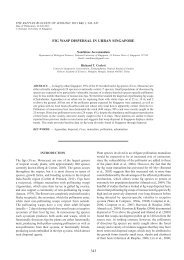1O257LF
1O257LF
1O257LF
You also want an ePaper? Increase the reach of your titles
YUMPU automatically turns print PDFs into web optimized ePapers that Google loves.
© 2010 Dinosauria International Ten Sleep Report Series No. 1<br />
of the new information provided by the Dana sample of<br />
Amphicoelias “brontodiplodocus”<br />
Amphicoelias “brontodiplodocus”<br />
The Dana specimens are sufficiently distinct<br />
morphologically to warrant the recognition of a new<br />
species, A. “brontodiplodocus”. Amphicoelias “brontodiplodocus”<br />
differs from Amphicoelias altus (including its synonyms), by<br />
the following characters: antorbital fenestra proportionately<br />
small; proatlas present; neural spine bifurcate past C 9 ;<br />
cervical ribs elongate, overlapping past centrum length;<br />
prezygapophysis on caudal vertebrae short; unfused<br />
clavicles present; ossified calcaneum; and claws tapered.<br />
Amphicoelias “brontodiplodocus” differs from Amphicoelias<br />
“Suuwassea” emilieae in lacking the following characters: no<br />
post parietal foramen, “optic” foramen not conjoined, neural<br />
spine bifurcation past C 9, and neural spines anteriorly<br />
positioned on cervical centra C 3-5. It is understood that<br />
the extraordinary completeness and preservation of the<br />
A. “brontodiplodocus” sample may be a factor in providing<br />
distinguishing characters that may be present but have not<br />
been documented in A. altus and A. emilieae. If proven to<br />
be the case, then all these species can be considered as one<br />
under A. altus.<br />
Thus, we recognize two or possibly three<br />
Amphicoelias species, a more primitive form A.<br />
“brontodiplodocus” in the lower part of the Morrison and a<br />
more derived species A. altus in the upper part. Both type<br />
specimens of Diplodocus hayi and Eobrontosaurus yahnahpin<br />
compare favorably in certain aspects with Amphicoelias<br />
“brontodiplodocus” and may offer taxonomically suitable<br />
names in a study which attempts to identify individual<br />
variation, sexual dimorphism and ontogeny. A possible<br />
third species A. emailieae may prove to be valid. Whether A.<br />
“brontodiplodocus” and A. altus overlap in time is not known.<br />
However, future discoveries of more complete specimens,<br />
particularly from classic upper Morrison localities, may<br />
close the morphological gap between A. “brontodiplodocus”<br />
and A. altus. Although this study recognizes a new taxon, we<br />
do not designate a type specimen until a suitable specimen<br />
is accessioned into an institution. The species name is used<br />
only for the purpose of communication and discussion in this<br />
report, and to call attention to the morphological distance<br />
and osteological uniqueness of the Dana sample. It is<br />
understood that the name A. “brontodiplodocus” is temporary<br />
and unofficial, and therefore should be considered a nomen<br />
nudum in accordance with ICZN guidelines.<br />
RECONSTRUCTION OF LIFE HABITS AND<br />
PALEOECOLOGY OF AMPHICOELIAS<br />
Since their initial discovery scientists have<br />
speculated about the life habits of sauropods in opposing<br />
scenarios. Originally they were depicted as feeble brained,<br />
solitary, aquatic reptiles, and then in later years, as herding<br />
animals with complex behavior, living in open dry savannah<br />
environments (Coombs 1975, Dodson 1990). Current<br />
speculation, based on Dana discoveries, portrays diplodocids<br />
somewhere in the middle of these two scenarios. They were<br />
highly evolved creatures well suited to extensive overland<br />
travel but preferring to live and feed in watery shore<br />
environments, a niche filled primarily by today’s wading<br />
birds. The key adaption for this niche is the ability to travel<br />
from one body of water to another. In the case of birds, flying<br />
is their method of travel, while diplodocids are perfectly<br />
adapted for terrestrial locomotion (Bakker 1971, Coombs<br />
1975, Alexander 1985, Carrano 2005, and others). Therefore,<br />
long distance travel may have been possible. The ability to<br />
migrate and to explore new resources confers a substantial<br />
ecological advantage to a species so that it is not restricted<br />
to a habitat in the same way aquatic animals are to water.<br />
This form of opportunistic feeding may have varied their<br />
food intake regionally and seasonally. Long before duckbilled<br />
hadrosaurs, wading birds, and specialized pterosaurs,<br />
the shore or wetland habitats may have been dominated by<br />
diplodocids throughout most of the Late Jurassic and Early<br />
Cretaceous Periods. Pterosaur diversity is well represented<br />
in the Cretaceous Period with many species displaying filter<br />
feeding capabilities. Fossil evidence for the existence of<br />
wading birds is not known until the Eocene, in the Green<br />
River Formation, Wyoming and the Messel oil shale pit near<br />
Frankfurt, Germany where a large diversity of species have<br />
occupied this niche until today.<br />
The Skull<br />
Of systematic importance, the Dana Quarry<br />
braincase of DQ-EN displays a clear basipterygoid fossa,<br />
a feature associated solely with specimens identified as<br />
Diplodocus (Wilson 2002, Whitlock et al 2010). On the other<br />
hand, Balanoff, et al (2010) considers the presence of this<br />
feature a sauropod plesiomorphy retained in Apatosaurus.<br />
The basipterygoid recess or fossa in the DQ-EN cranium<br />
can be described as a clear depression, circular in outline<br />
located at the base where the pterygoid processes converge.<br />
This feature is also present in CM 11255, CM 11161, CM<br />
26552, the holotype braincase of Diplodocus hayi HMNS 175<br />
(Holland 1906), and the braincase BYU 17096 identified<br />
as Apatosaurus. Whether, this feature represents a species,<br />
gender, or ontogenetic trait remains questionable, however,<br />
its present distribution suggests that it is a synapomorphy of<br />
36



